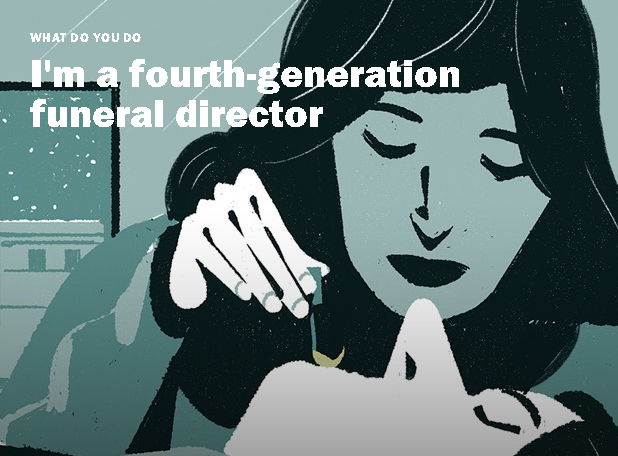What Do You Do: I’m a fourth-generation funeral director
A funeral director tells us about growing up in a funeral home, postmortem cosmetics, and “wowing” families at funerals, as part of Hopes&Fears’ anonymous interview series.
Article By Whitney Kimball, Hopes & Fears
I’M A FOURTH GENERATION FUNERAL DIRECTOR. In total, we have 17 funeral homes — my dad and three of his cousins are the four owners, and they each operate a separate division. So although we’re one company, we operate day-to-day as four separate little companies. I work with my father, my brother, my cousin, and four other funeral directors, and together the eight of us run four funeral homes.
So it’s been in my family for a while…in fact, my family lived in a funeral home until I was twelve. A lot of people ask, “Were you scared?” And well, I was so little. I was a baby, I didn’t know any different. I just thought everyone lived in a funeral home.
I have a brother who’s two years younger than me. When he was little, he would run around the funeral home, and run up to dad and ask “Daddy! Who got died?”
And then Dad would lift him up, let him look down in the casket and say “That’s who got died, son,” and my brother would say “Okay!” and Dad would set him down, and he would take off again, running. So, I think we didn’t know that it was strange to be around people who were deceased until we went to school and people told us it should be weird. I know in elementary school, I had a couple of friends who wouldn’t come to sleepovers at a funeral home. One friend had her grandpa’s service here– I didn’t understand back then, but now I get it– I wouldn’t want to come back either, because it would bring up bad memories.

People get freaked out by the idea of taking care of the dead as a living, but I just think people really don’t know any better. The job’s more about the people who are still alive– really, most of my time is spent fielding phone calls and meeting with people, making videos, and printing paper goods…talking to newspapers and arranging military honors, all that kind of stuff. The actual preparation of the body is really only about 30% of the day.
Because the work comes in at all times, there really is no end of the day. Last year, we did 499 funerals– so breaking that down, it’s obviously more than one person a day, but some weeks we’re beyond busy and other weeks we’re slow (and start looking for something to clean or organize). Our funeral home is on a rotation, so we take shifts every other night to be on call after 5 o’clock. So if someone should pass away, my on-call partner or I will be the ones to respond.
The best days are the ones where you’re up all night because someone (or several someones) passed away. Death is anything but convenient and those are the days no one envies our job. We call them “removals.” If it’s at a home, we go together to make sure there are two people there since we’re walking into an unknown situation. If it’s in a facility, like a hospital, where there are nurses or other people around to help, we can just send one person. So 3 AM, we get the phone call, we throw on a suit, we run into the office, we grab the cot, and we go to wherever the person passed away.
Every funeral home is different, but we do a rotation to make sure that we don’t get every single Christmas on, or every single Thanksgiving. You can’t have both, and you can’t choose which one. It’s just luck of the draw. And then you get every other weekend off.
So it’s a lot of work, and I think that’s why a lot of people get burnt out early in a funeral directing career. But it’s all about serving the people and being there because, gosh, if my mom passed away I would want someone to come right then because it’d mean the world to me.

I have a brother who’s two years younger than me. When he was little, he would run around the funeral home, and run up to dad and ask“Daddy! Who got died?”
Most families, I’d say, still want to see their loved ones before they’re buried or cremated. For them, we do the process called ‘embalming,’ which is basically a process of flushing the blood out of the body and replacing it with a fluid comprised mostly of water and preservative solutions. Even if it’s in the middle of the night, we do it right then because the sooner you get started on that process, the better your results are gonna be. We use the existing circulatory system to introduce the preservatives, so the longer somebody sits there, the more their body is going to naturally break down, and those circulatory systems will get disrupted on their own.
There’s no way to get 100% of the blood out, but removing most of it slows down the decomposition process. As you can imagine, when we die, the blood settles to the lowest point; so the cool thing is that you know whether the embalming process is working or not because you can see the effects outside the body. There are a couple of signs, like distention– when you can see physically the little bump where the vein or artery lies under the skin and is no longer laying flat (check out the inside of your own wrists for an example). And then just the coloring; once you get the circulatory system moving again, you can see the pinkness of the dyes coming back into their cheeks or maybe even their fingernails.
There’s a lot of chemistry involved…we usually use about 3 gallons of fluid for each person. Many times, we use a product known as ‘tissue-fill’– if someone lost a terrible amount of weight, we can fill them up a little bit so they look a little more like they do in their pictures, so their family and friends recognize them from before the illness. For that, we fill a syringe with the tissue-fill and apply it under the skin in the necessary areas. We can also– the fancy term is ‘restrict the drainage’– if you restrict drainage, you’re stopping the fluids, including some of the blood, from escaping. So that will kind of fill in the areas that are otherwise lacking in fluids all over the body. Or if someone’s put on a lot of weight, then we use a solution that is designed to draw out water from the body. You’ll see this very often with people who’ve been on an IV drip– a lot of that water might be retained, so they kind of swell up. Or maybe someone’s jaundiced, we have special fluids that will help us get rid of that yellow tone.
It’s a very interesting science-slash-art because, while there’s still science involved, you want them looking good. So that’s sort of an artsy-type skill, to know when to stop orhow to use the right formulas to make them look more lifelike.




